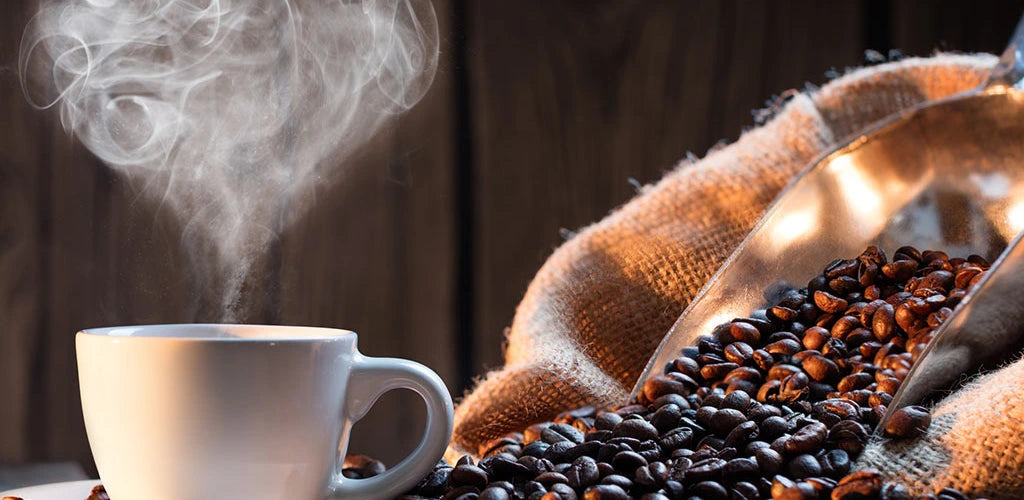
7 Facts About Coffee Roasting

If you’ve ever wondered exactly where roasted coffee beans come from or sipped on a delicious latte and pondered the facts of coffee roasting, then this is the place to be!
Coffee is one of the few things in existence that transcends borders, language barriers, and even time itself. Across the ages and the globe, coffee is enjoyed by many. Initially invented in the 15th century Ottoman Empire, roasting green coffee beans into sippable goodness was first done in a shallow pan resembling a giant metal spoon. Sipping a hot cup of coffee was a luxury. These days, you can purchase coffee products at specialty coffee shops, grocery stores, and even boutiques. Still, many don’t consider the rich history and labor-intensive, passion-filled process that gets the beans from field to cup.
The art of roasting coffee beans is just that, an art. One that has to be learned and passed on to new generations. It is constantly evolving, and new roasting technology is added to the mix frequently. Needless to say, we could gush on forever detailing every exciting notion and captivating story about coffee roasting. But we’ll save that for the future! Today, we’ve narrowed down seven facts about coffee roasting that speak to the many facets of this incredible process.
Fact 1: The Two Main Types of Coffee Roasting Are Drum Roasting and Air Roasting

Roasting coffee beans is the process of transforming green coffee beans into a final product using heat. The end results are determined by the roasting process, and the decisions roasters make during each unique batch. Flavors vary greatly depending on the approach.
Drum roasting involves a large metal drum that holds green coffee beans. An external element heats the drum using any number of methods, including electricity and gas.
Air roasting is a different approach. Hot air superheats the beans quickly, turning them into a finished product. Rather than cooking the beans in a drum using conduction, where the beans come into contact with a hot metal surface directly, air roasters use primarily convection to heat beans indirectly by way of hot air streams. In some machines, green coffee beans get suspended in a chamber of hot air fueled by electricity. In other gas-powered devices, hot airflow comes through a perforated grate, and the beans are moved along on a conveyor belt.
Drum roasters and air roasters are capable of producing a similar volume. However, air roasting is a faster process. An air roaster can produce in as little as six to eight minutes, half the time of a traditional drum roaster. Whether or not a roaster chooses to roast in an air roaster or a drum roaster is subjective, driven by taste and preference.
Fact 2: Coffee Roasters Listen to Their Beans

One of the most foundational ways roasters hone their batches is by listening to the tell-tale signs of the roasting process, which comes in the distinct signaling of “cracks.” First crack is an audible change in the sound of beans as they roast. The physical cracking of coffee beans causes the sounds as they expand due to heat and moisture evaporating from inside the bean. This causes pressure, leading to beans cracking open, signaled by a short, sweet orchestra of coffee bean percussions. Depending on the desired end result, this first crack helps a roaster guide the batch.
Coffee cracks twice while roasting, but light and medium roasts are cooled sometime after the first crack and before the second crack. Dark roasts are generally roasted with a first and second crack, allowing more time for the bean to darken and moisture to evaporate.
Detecting the first and second crack is important to the coffee roasting process. As the beans undergo intense chemical changes that transform their flavor, their physical state signals these complex, unobservable changes to the roaster. Listening to beans as they roast and observing their color, and analyzing their scents is crucial if a roaster wants control over the flavor profile and reliability of a batch.
Fact 3: Roasts Are Divided Into Four Distinct Groups Based on Color

Light: Light brown color and a non-oily surface. Flavor notes inherent to the green bean shine through, like nuttiness and fruitiness. Light roasts have the highest level of acidity.
Medium: Medium-brown color and some sweetness. A balance of flavor and acidity.
Medium-Dark: Rich color with some shine to it. Bittersweet aftertaste with low acidity levels.
Dark: Bold, dark, oily-looking beans with high bitterness levels. The flavor of the roast outshines the original flavor of the bean. It is achieved by roasting the beans past the second crack.
While color dictates the roast classification, flavor profiles and caffeine potency are defining factors of each roast color. Traits are consistently shared by roast categories because the flavor and roast level work symbiotically, directly impacting one another as beans transform.
Fact 4: Roast Levels Affect Flavor Profiles and Caffeine Potency

Depending on the level of chemical transformations a roaster allows beans to endure, by pulling before the second crack or not, flavor and caffeine potency change. Because coffee roasting aims to achieve particular flavor profiles, understanding caramelization and the Maillard reaction is crucial. Both of these stages occur prior to the first crack.
The Maillard reaction occurs as visible browning appears. It is the chemical reaction between amino acids and sugars, as the natural sugars are lost. It is responsible for the darkening of the outside of the beans.
Caramelization happens after the Maillard reaction as final natural sugars dissipate by way of heat, giving off carbon dioxide and oxygen. As these gases build-up, the first crack occurs, and caramel flavors develop. If the heat continues, the heat enhances bitterness as sugars dry up. Sometimes, these reactions occur in quick succession and are hard to predict with specificity.
Caffeine is impacted throughout the process in a similar way to the naturally occurring sugars. The longer the duration of heat beans are exposed to, the less caffeine is left. So, contrary to what many believe, light roasts are slightly higher in caffeine than dark roasts. However, this difference is minimal, and some argue that the loss is unnoticeable.
Fact 5: Coffee Beans Need Time to Degas

Many individuals new to roasting miss this! As coffee undergoes spectacular changes to its cellular structure during a roast, gases build up inside the bean. Carbon dioxide and other gases need time to escape naturally. If a roaster skips this step, they might end up with a bag of beans that look like a balloon or unpredictable flavors when brewed.
Degassing impacts the quality of brewed coffee beans. Coffee that has not had adequate time to degas forms air pockets between the coffee grounds and the water, leading to uneven extraction. However, some CO2 retention is necessary for coffee to taste fresh. Otherwise, a flat and stale cup can result from too much degassing.
Fact 6: Green Beans Weigh More Than Roasted Beans

Now that you know about the chemical and physical reactions endured by beans during the roasting process, it should make sense to learn that roasted coffee beans weigh less than green beans. Juicy coffee cherries (the raw, unprocessed form of coffee beans) go through initial drying and processing after they are harvested from the plant.
By the time they have been dried into green coffee beans, they still retain up to 12.5% water, according to International Coffee Organization standards. As green beans endure intense heat in the roasting process, they lose additional moisture. By the end of the process, green beans lose around 16% of their weight once roasted.
Fact 7: Coffee Roasting Connects Communities

To be a coffee roaster, you have to have a way of sourcing green coffee beans. Green coffee beans result from coffee cherry farming which involves growing, harvesting, and drying the cherries. Coffee is grown around the world and then shipped thousands of miles to suppliers and coffee roasters.
By connecting individuals in foreign countries to others in distant lands, coffee stimulates global knowledge sharing and enhances connections between humans. The art of coffee roasting honors the origin of the coffee bean and the journey it takes to get from the hands of a farmworker to the drum of a roaster to the smooth walls of a porcelain cup.
Learn More About Coffee Roasting With CoffeeTec
At CoffeeTec, we have the privilege of working with coffee industry professionals from varying backgrounds, locations, and coffee roasting philosophies. From air roasting to drum roasting, manual roasting to automated roasting, there is a coffee roasting niche for everyone.
If you find yourself staring down the coffee roasting path or looking to upgrade your current setup, CoffeeTec has new and used state-of-the-art equipment at unbeatable prices. We are passionate about guiding coffee roasters into their next great roast, whether it be with helpful advice from our knowledgeable staff or reliable roasting equipment from our vast online catalog.
Have Additional Questions?
We’re here for you and would love to help you make the best purchasing, design, or layout decisions for your coffee roastery’s operations. No matter where you are in your coffee journey, we want to see you succeed. Check out our consulting and education services.
Perhaps you’re interested in financing or are considering the option and benefits of buying used. We’ve got you covered for both. Finally, feel free to explore our FAQs, and if you still don’t have answers to your questions, contact us. Let’s help you build the coffee roastery of your dreams!


Leave a comment